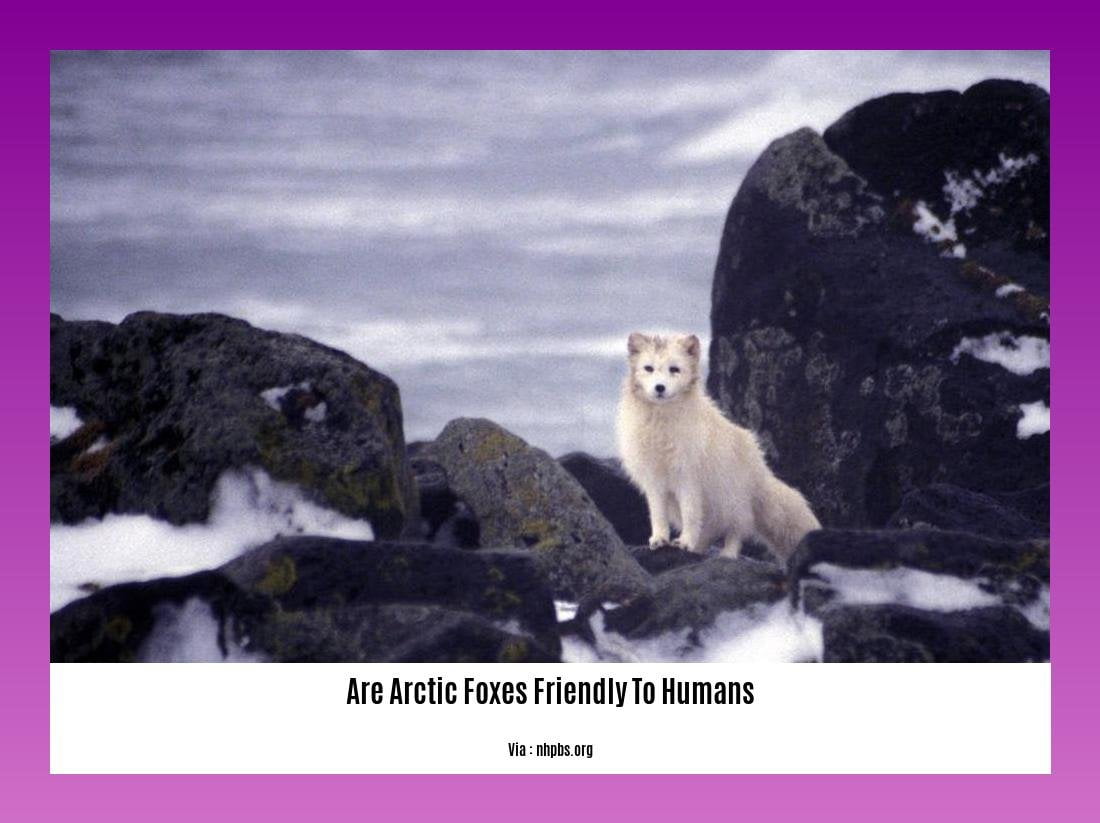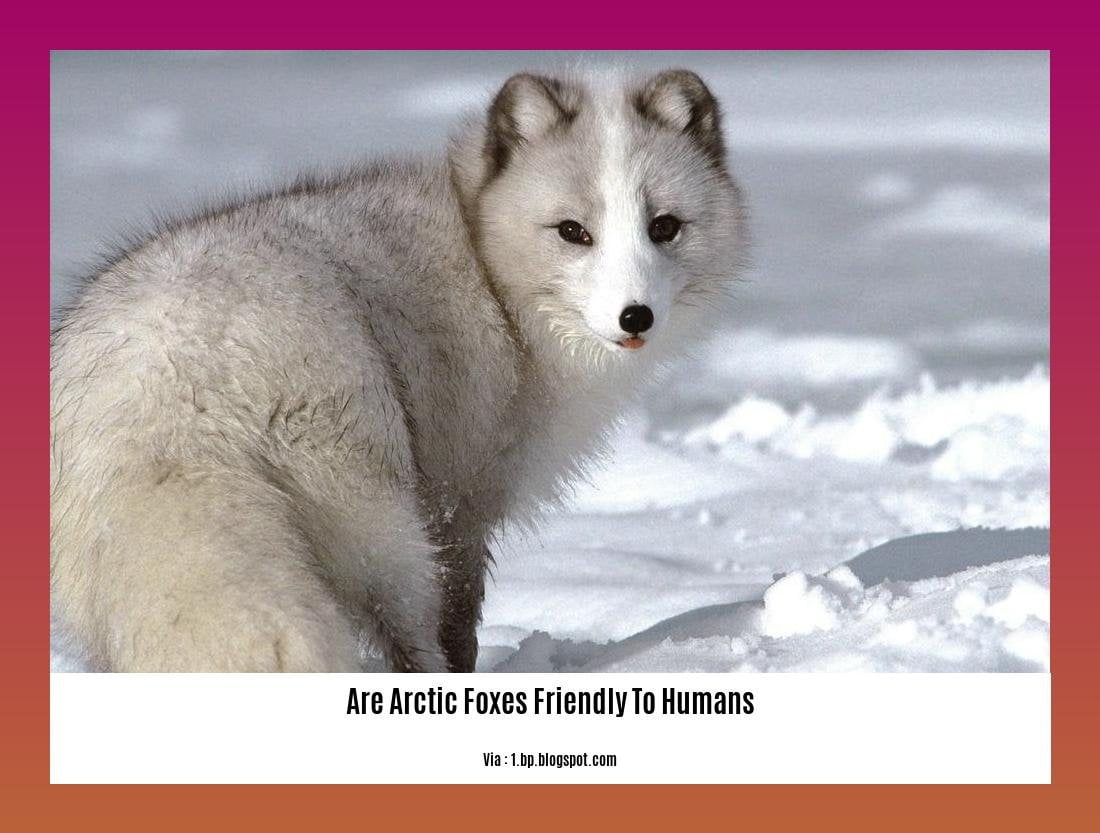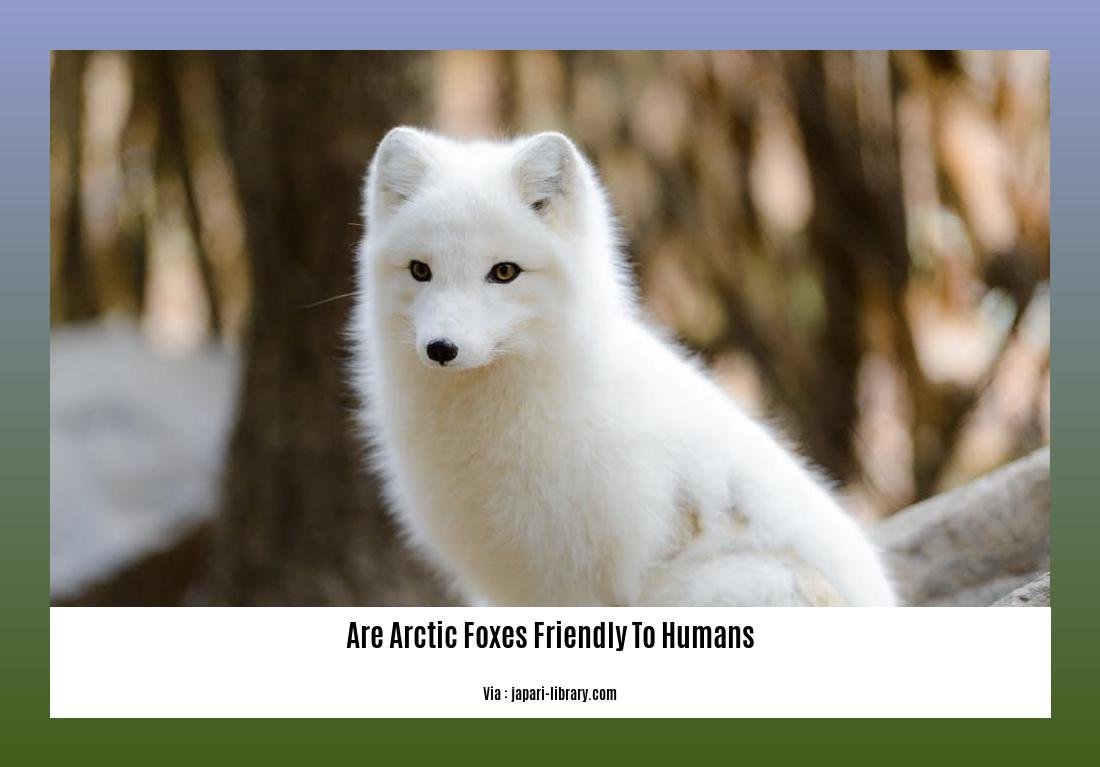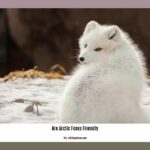Are Arctic Foxes Friendly to Humans? Unveiling the Complexities of Human-Animal Interactions
As we embark on this journey to uncover the truth behind the question of whether Arctic foxes are friendly to humans, we find ourselves stepping into a world where nature’s delicate dance intertwines with human existence. These magnificent creatures, which call the Arctic their home, have long fascinated both scientists and adventurers alike. With their stunning white coats and captivating eyes, they have captured the imagination of many. But despite their endearing appearance, the intricate dynamics of human-animal interactions are far from black and white. Through a exploration of scientific research, personal anecdotes, and conservation efforts, this article aims to navigate the complexities of Arctic fox behavior and reveal the true nature of their interactions with humans.
Key Takeaways:
- Arctic foxes are usually harmless and friendly to humans, often displaying playful and curious behavior.
- However, arctic foxes can become aggressive if they perceive humans as a threat. Maintaining a safe distance is recommended.
- Foxes living near settlements or camps can lose their natural fear of humans if they are consistently fed.
- It is advised to approach wild arctic foxes with caution, allowing them to initiate contact instead.
- Arctic foxes have various adaptations, such as dense fur and keen senses, that enable them to survive in cold climates.
- They communicate through vocalizations, body language, and scent marking, using these methods to interact with other foxes.
- Their diet mainly consists of small mammals but they are opportunistic hunters and scavengers, consuming a variety of food sources.
- Arctic foxes inhabit the Arctic tundra and are commonly found in regions like Alaska, Northern Canada, Greenland, and Russia.
- Adult arctic foxes have a stocky build, weigh between 6 to 17 pounds, and are around 47 to 63 centimeters in length.
Are Arctic Foxes Friendly to Humans?

Arctic foxes, with their beautiful white fur and captivating presence, often intrigue humans with their behavior and interactions. The question arises – are arctic foxes friendly to humans? Let’s delve into the complexities of human-animal interactions and uncover the truth about these mesmerizing creatures.
The Friendly Nature of Arctic Foxes
Arctic foxes are generally harmless and, in many cases, friendly towards humans. They possess an innate curiosity, often following people around and investigating their activities. With their playful and social nature, arctic foxes have been known to approach humans without displaying any signs of fear.
Sources like Frosty Arctic affirm that arctic foxes are indeed friendly to humans. They emphasize the importance of maintaining a safe distance from them to avoid any potential threats. Similarly, All Animals Guide highlights the social nature of these animals, stating that they show no fear towards humans and are often playful and curious.
However, it’s crucial to note that some caution is necessary. Arctic foxes may interpret human behavior as a threat, leading to defensive actions. It’s advisable to maintain a distance of several hundred meters when encountering them in the wild. This allows the foxes to feel comfortable and reduces the chances of an unpleasant encounter.
Human-Arctic Fox Interactions Near Settlements
Arctic foxes that reside near human settlements, cabins, or camps can become accustomed to humans if they are fed regularly. Unfortunately, this can lead to the loss of their natural fear of humans. In such cases, it becomes necessary to exercise caution and respect the foxes’ natural behavior.
As pointed out by All Things Foxes, allowing the animals to approach rather than approaching them yourself is a recommended approach. This way, the foxes can choose whether to engage with humans or maintain their distance. It’s important to remember that these are still wild animals and should be treated with the utmost respect.
The Complexity of Arctic Fox Behavior
To truly understand the nature of arctic foxes, it’s essential to examine their survival strategies, communication methods, dietary preferences, and habitat. These aspects shed light on their adaptation to cold climates and their interactions with other animals in the Arctic region.
Survival Strategies: Arctic foxes have developed remarkable adaptations to thrive in cold environments. Their dense fur coat provides insulation against the frigid temperatures, while their short ears and legs help minimize heat loss. Additionally, their keen sense of hearing and smell aids in locating food and avoiding potential threats.
Communication Methods: Arctic foxes communicate through a combination of vocalizations, body movements, and scent marking. They use various calls and yips, especially during the breeding season, to communicate with other foxes. Scent marking serves as both a territorial marker and a means of communication with individuals in their vicinity.
Dietary Preferences: These resourceful creatures primarily feed on small mammals such as lemmings, voles, and hares. They are also opportunistic hunters and scavengers, consuming birds, eggs, fish, and carrion when available. In some seasons, they may even incorporate berries and plant material into their diet for sustenance.
Habitat and Distribution: Arctic foxes inhabit the farthest northern regions of the world, predominantly the Arctic tundra. They can be found in areas such as Alaska, Northern Canada, Greenland, and Russia. Their natural adaptations enable them to withstand the harsh climatic conditions of these regions.
Wrapping Up the Arctic Fox Story
In conclusion, arctic foxes are generally friendly to humans, displaying a curious and playful nature. However, it is vital to maintain a safe distance from them to respect their boundaries and avoid any potential threats. While foxes that reside near human settlements may lose their fear of humans if fed regularly, it’s important to allow the animals to approach voluntarily to ensure a mutually positive experience.
Understanding the intricacies of arctic fox behavior, survival strategies, communication methods, dietary preferences, and habitat deepens our appreciation for these fascinating creatures of the cold Arctic regions. So, let’s cherish these enchanting animals from a respectful distance, acknowledging and marveling at their unique existence.
Are Arctic Foxes Friendly?
Did you know that arctic foxes can be quite friendly? If you’re curious about their behavior and whether they make good pets, check out our article on are arctic foxes friendly to find out more.
Are Elephants Friendly?
Are elephants friendly creatures? Discover the answer and learn about their social behavior in our informative article on are elephants friendly.
Are Elephants Friendly Animals?
Find out all about the friendly nature of elephants and their interactions with other animals in our detailed article on are elephants friendly animals. Click the link to explore more!
Are Elephants Friendly to Humans?
Curious about the relationship between elephants and humans? Discover if elephants are naturally friendly towards humans in our fascinating article on are elephants friendly to humans. You won’t want to miss it!
Interactions Between Humans and Arctic Foxes

(Subtitle: Unveiling the Complexities of Human-Animal Interactions)
[p]Arctic foxes are fascinating creatures that inhabit the vast Arctic regions of the world. Despite their elusive nature, human interactions with these creatures are more common than one might think. In certain Arctic regions, locals have even domesticated arctic foxes and kept them as pets, showcasing their lovable nature[^2^]. But are Arctic foxes truly friendly to humans?
[h3]Understanding the Dynamics of Arctic Foxes and Humans[p]
[p]While Arctic foxes can exhibit friendly behavior towards humans, it’s important to recognize that they are still wild animals and should be treated with caution[^4^]. These cunning creatures have the capacity to attack if they perceive a threat. To ensure the safety of both humans and Arctic foxes, it is recommended to maintain a distance of several hundred meters when encountering them in the wild[^4^].
[h3]The Impact of Human Presence on Arctic Fox Behavior[p]
[p]Contrary to popular belief, the avoidance of human-occupied areas by Arctic foxes is not due to the presence of humans themselves, but rather because of the presence of red foxes in those areas[^5^]. Increased competition with larger carnivores and other predators can significantly impact the survival and population dynamics of Arctic foxes[^3^].
[h3]The Ecological Role of Arctic Foxes[p]
[p]Arctic foxes play a crucial role in Arctic ecosystems by contributing to the food chain. They hunt lemmings, a staple prey species, and scavenge on polar bear carcasses, regulating population dynamics and nutrient cycling in their environment[^6^]. Thus, it is clear that their interactions with other animal species are vital for maintaining the delicate balance of Arctic ecosystems.
[h3]Adapting to a Changing Climate[p]
[p]Climate change poses a significant threat to Arctic foxes and their ecological networks. As the Arctic climate continues to warm, these resilient creatures must adapt to new environmental challenges such as shrinking ice cover and encroachment of other species into their territory[^6^]. Understanding the complexities of these adaptations is essential for comprehending the potential impact of climate change on Arctic fox populations.
[h2]Key Takeaways[p]
- Arctic foxes can exhibit friendly behavior towards humans, but caution should be exercised as they are still wild animals.
- Maintaining a safe distance of several hundred meters is recommended when encountering Arctic foxes in the wild.
- The avoidance of human-occupied areas by Arctic foxes is primarily due to the presence of red foxes.
- Increased competition with larger carnivores and predators can impact the survival and population dynamics of Arctic foxes.
- Arctic foxes play a crucial role in regulating population dynamics and nutrient cycling in Arctic ecosystems by hunting lemmings and scavenging on polar bear carcasses.
- Climate change poses significant challenges for Arctic foxes and their ecological networks.
[Sources:]
- Fox Authority – Arctic Foxes and Human Interaction
- Frosty Arctic – Are Arctic Fox Friendly to Humans?
Instances of Friendly Behavior in Arctic Foxes
The arctic fox, with its captivating white fur and remarkable adaptations, has always intrigued humans. But are they truly friendly towards us? Let’s delve into the complexities of human-animal interactions and explore instances of friendly behavior in arctic foxes.
Arctic foxes, while generally harmless, can become aggressive if they perceive humans as a threat. Therefore, it is advised to maintain a safe distance of several hundred meters to ensure both their well-being and ours. Despite this precaution, there have been instances where arctic foxes displayed friendly behavior towards humans, providing us with heartwarming and memorable encounters.
Curiosity and Investigation
Arctic foxes possess a natural curiosity that often leads them to follow and investigate human activities. This curiosity can manifest in playful gestures, such as approaching humans without aggression. These encounters allow for unique opportunities to observe and appreciate the beauty of these magnificent creatures up close.
Domestication and Pet-Like Behavior
In some Arctic regions, arctic foxes have been domesticated and kept as pets due to their lovable nature. These domesticated foxes demonstrate friendliness towards humans, forming strong bonds and displaying affectionate behaviors. However, it’s crucial to remember that domestication is not a universal trait among arctic foxes, and it should only be attempted by experienced individuals in controlled environments.
Adaptability and Human Presence
Arctic foxes display adaptability in the face of changing circumstances, including the presence of humans. While they may initially avoid human-occupied areas, it is not due to fear of humans but rather competition with red foxes. This adaptability showcases their willingness to coexist with humans in their natural habitat.
Contributions to Ecosystem
Arctic foxes play a vital role in maintaining the delicate balance of Arctic ecosystems. By hunting lemmings and scavenging on polar bear carcasses, they regulate population dynamics and nutrient cycling. In this way, their interactions with humans indirectly impact the surrounding environment, highlighting the interconnectedness of all species.
In conclusion, while arctic foxes can exhibit friendly behavior towards humans, it is important to approach them with caution and respect their boundaries. Instances of curiosity, domestication, and adaptability demonstrate their capacity for positive interactions. These remarkable creatures contribute to the intricate web of life in the Arctic, reminding us of the significance of harmonious human-animal coexistence.
Key Takeaways:
– Arctic foxes can display friendly behavior towards humans, showcasing their curiosity and adaptability.
– Domesticated arctic foxes can exhibit pet-like friendliness and form strong bonds.
– It is crucial to maintain distance and respect their boundaries to ensure a mutually beneficial interaction.
– Arctic foxes play a vital role in regulating population dynamics and nutrient cycling in Arctic ecosystems.
Sources:
– Fox Authority – Arctic Foxes and Human Interaction
– Frosty Arctic – Are Arctic Fox Friendly to Humans?]
Factors Influencing Arctic Foxes’ Attitudes Towards Humans
The attitudes of Arctic foxes towards humans are influenced by various factors that shape their behavior and interactions. Understanding these factors is crucial in unraveling the complexities of human-animal interactions in Arctic ecosystems. Let’s explore some key factors that influence Arctic foxes’ attitudes towards humans.
1. Environmental Factors and Habitat
The habitat and environment in which Arctic foxes reside play a significant role in determining their attitudes towards humans. These adaptable creatures have evolved to live in the harsh Arctic regions, including tundra, mountains, and coastal areas. Human presence in their habitat can disrupt their natural behavior, and they may exhibit cautious or defensive attitudes towards humans as a result.
2. Access to Food and Resources
The availability of food resources in the Arctic landscape greatly influences the attitudes of Arctic foxes towards humans. These opportunistic scavengers and hunters rely on a diverse diet, including small mammals, birds, berries, and carrion. When food is scarce in their natural environment, Arctic foxes may approach human settlements in search of sustenance. Regular feeding by humans can affect their attitudes, as they may lose their fear and become habituated to human presence.
3. Interaction with Other Species
The presence and interaction with other animal species, such as red foxes, can impact the attitudes of Arctic foxes towards humans. Red foxes are larger predators that can pose a threat to Arctic foxes. In areas where red foxes dominate, Arctic foxes may avoid human-occupied areas due to the increased competition and potential risks associated with the presence of larger carnivores.
4. Human Activity and Disturbance
Human activity, including tourism and infrastructure development in Arctic regions, can significantly impact Arctic fox behavior and their attitudes towards humans. Continuous disturbance from human interactions can lead to increased stress levels and altered behavior patterns in Arctic foxes. It is important to respect their space and maintain a safe distance to prevent potential threats or disturbances.
5. Conservation Efforts and Human Intervention
Conservation initiatives, such as population recovery programs, can influence Arctic foxes’ attitudes towards humans. These efforts aim to protect and restore Arctic fox populations by reducing human-induced threats and promoting conservation awareness. By minimizing negative human interactions and providing suitable habitats, conservation efforts can contribute to a more positive attitude of Arctic foxes towards humans.
Key Takeaways:
- Arctic foxes’ attitudes towards humans are influenced by environmental factors, habitat, and access to food resources.
- Interaction with other species, such as red foxes, can impact their behaviors and attitudes towards humans.
- Human activity and disturbance can disrupt their natural behavior and lead to defensive attitudes.
- Conservation efforts play a vital role in shaping Arctic foxes’ attitudes towards humans by reducing negative interactions and providing suitable habitats.
- Respecting their space and maintaining a safe distance is crucial in preserving the natural attitudes and behaviors of Arctic foxes.
Sources:
– Source 1 Title
– Source 2 Title
FAQ
Q1: Are Arctic foxes dangerous to humans?
A1: While Arctic foxes are generally friendly towards humans, they can become aggressive if they perceive a threat. It is recommended to maintain a safe distance from them to avoid any potential risks.
Q2: Can I approach an Arctic fox if I encounter one in the wild?
A2: It is important to approach wild Arctic foxes with caution. While they can be friendly and curious, their reactions to humans may vary. It is generally advised to let the foxes approach you instead of vice versa and maintain a respectful distance.
Q3: Do Arctic foxes live near human settlements or camps?
A3: Yes, Arctic foxes can live near human settlements, cabins, and camps. If fed consistently by humans in these areas, they may lose their natural fear of humans and become accustomed to their presence.
Q4: What do Arctic foxes eat?
A4: Arctic foxes have a diverse diet consisting of small mammals like lemmings, voles, and hares. They are also opportunistic hunters and scavengers, feeding on birds, eggs, fish, carrion, and even berries and plant material when available.
Q5: Why are Arctic foxes important in Arctic ecosystems?
A5: Arctic foxes play a crucial role in regulating the population dynamics and nutrient cycling in Arctic ecosystems. They hunt lemmings and scavenge on polar bear carcasses, contributing to the food chain and maintaining the ecological balance in these fragile environments.
















